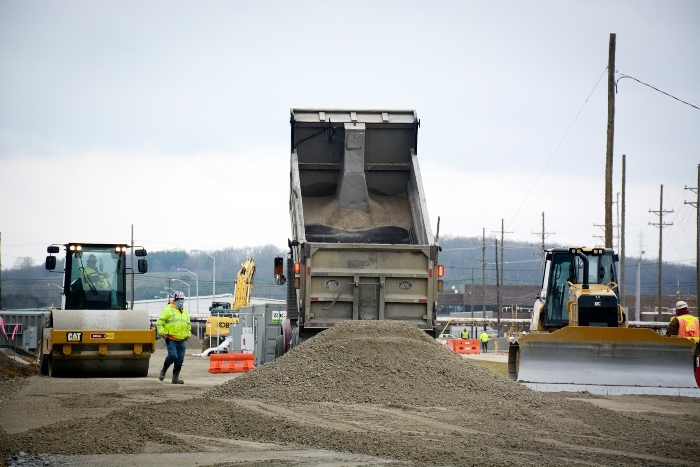 Crews deliver a load of dirt near the X-326 building as work continued on haul road construction.
PIKE COUNTY, Ohio – Crews are working to finish construction of a dedicated road at EM’s Portsmouth Site that will be used to haul demolition material to the new On-Site Waste Disposal Facility (OSWDF).
The road will stretch approximately 2.75 miles and will provide a dedicated route to the OSWDF for trucks carrying debris and soils generated from demolition of the former gaseous diffusion plant and excavation of legacy landfills and groundwater plumes.
“Structural demolition will begin on the first of three massive uranium-enrichment process buildings here in late spring, generating debris,” said Jeff Bettinger, Portsmouth site lead for the Portsmouth/Paducah Project Office. “This haul road will provide a safe and reliable transportation route from the demolition zone to the OSWDF.”
DOE has developed a comprehensive plan, approved by the Ohio Environmental Protection Agency, that will provide safety as the waste is being transported.
“With the disposal cell opening in the near future, the existence of a dedicated haul road will become increasingly important to the project,” said Craig Cecala, OSWDF operations manager with Fluor-BWXT Portsmouth, the site’s prime cleanup contractor. “The haul road is designed to expedite delivery of accepted waste to the cell, where workers will be able to efficiently survey loads before and after transport.”
-Contributors: Donnie Locke, Aaron Mosley, Michelle Teeters
 The Mexican spotted owl, which finds a home in northern New Mexico’s canyons and forests, is a threatened species that the EM Los Alamos Field Office and contractor N3B strive to protect. (Photo courtesy of Don Ulrich, taken in Flagstaff, Arizona.)
LOS ALAMOS, N.M. – To protect a treasured ecological species of northern New Mexico, EM’s Los Alamos Field Office (EM-LA) and primary contractor N3B on March 1 began their annual task of modifying legacy waste cleanup activities at Los Alamos National Laboratory (LANL) ahead of the Mexican spotted owl breeding season.
The U.S. Fish and Wildlife Service (USFWS) listed the Mexican spotted owl as a threatened species in 1993, when population numbers were decreasing drastically due to the loss, degradation, and fragmentation of their habitat.
In 1999, DOE and the National Nuclear Security Administration coordinated with the USFWS to create a habitat management plan to safeguard protected species at LANL.
In compliance with that plan, EM-LA and N3B modify fieldwork each year during the spotted owl’s breeding season in locations identified as core habitat areas and buffer zones. Such areas — typically rocky, steep-walled canyons and old growth conifer and pine-oak forests — contain ideal nesting habitats for New Mexico’s spotted owls, which generally return to the same nests each year. The buffer zone, which extends 400 meters past the core habitat area, provides further protection.
“In addition to experiencing habitat degradation, spotted owls, which typically have the same mates for life, have a low reproduction rate, so survivability of their offspring is incredibly important,” N3B environmental specialist Don Ulrich said.
Activities that EM-LA and N3B modify include those that cause habitat alterations — or changes to the soil structure, vegetation, prey quality and quantity, water quality, or noise and light levels — regardless of whether survey crews identify owl nesting pairs.
In areas where crews do locate nesting pairs, so-called disturbance activities are also avoided. Areas with known spotted owls remain restricted through Aug. 31. In areas where owls aren’t detected, regular fieldwork may resume as early as May 31.
“Project managers know the closures come every year, so they plan ahead and prioritize other projects,” Ulrich said. “The owls’ existence is valuable, and we strive to protect and create space for other species.”
With USFWS concurrence, all sampling and monitoring of groundwater, surface water, stormwater, and sediment will continue during nesting season These activities ensure EM-LA maintains compliance with the 2016 Consent Order for site cleanup.
-Contributor: Kate Keenan
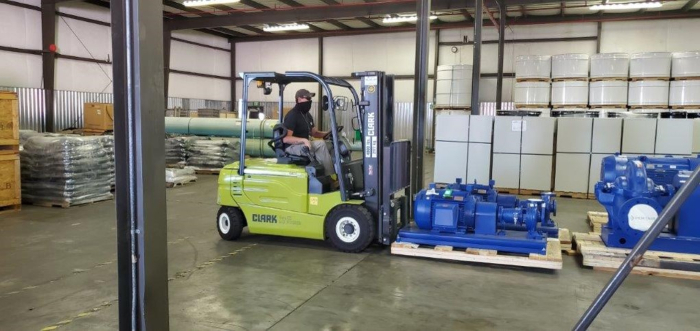 A worker on the Hanford Site delivers a pump for a modernization project that will upgrade the Hanford Site’s untreated water system to meet increased demands during future 24/7 tank waste treatment operations and critical risk-reduction cleanup.
RICHLAND, Wash. – Workers will soon begin testing and commissioning upgrades to one of two water systems on the Hanford Site to ensure the site’s infrastructure will support long-term cleanup activities, including the Direct-Feed Low-Activity Waste (DFLAW) program for treating tank waste and other risk-reduction cleanup.
Managed by EM contractor Hanford Mission Integration Solutions (HMIS), the project includes new pumps, piping, valves, and electrical infrastructure for Hanford’s untreated water system, which processes 400 million gallons a year. A key upgrade adds on-demand pumping, which improves energy efficiency and the service life of equipment.
The project also includes a number of updated technologies for improved monitoring and control of water flow and detection of system equipment problems, and a new local area network dedicated to system automation and control. The site's two water systems — one for untreated water and the other for treated water — are independent of each other. The treated water system is working effectively.
“This system upgrade supports a number of facilities and activities on the Hanford Site, including fire suppression capabilities for the Central Plateau, a high-priority cleanup location,” said Jeffrey Frey, DOE assistant manager for mission support at Hanford. “DOE is on the verge of treating Hanford’s tank waste, when the demand for water will increase, and these upgrades will ensure a reliable water supply for the entire mission at the site.”
 Workers lift a new pump into a reservoir on the Hanford Site as part of planned upgrades to the site’s untreated water system.
Prior to the planned automation, HMIS workers operated most pumps and support components manually. Following the upgrades, workers will be able to monitor water system components using a control room computer, and they will receive updates via text message or email when in the field.
“This water project will be the first at Hanford to include a new instrumentation control system tied to a dedicated local area network,” said Diane Cato, vice president of engineering, technology, and projects for HMIS. “We will be able to detect equipment problems earlier, complete maintenance before a large system failure, and reduce downtime to ensure the water system is ready to support 24/7 operations at the Hanford Site.”
The new system will begin initial operations this year, with full startup operations planned by 2022.
-Contributor: Robin Wojtanik
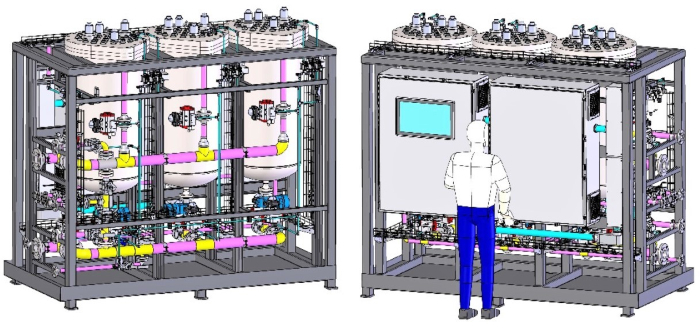 This front-and-back illustration shows a new filter system that will eliminate the need to shut down operations every 12 hours for filter replacement during wastewater processing at the Hanford Site’s Effluent Treatment Facility, which is being upgraded to support 24/7 tank waste treatment operations.
RICHLAND, Wash. – EM Office of River Protection (ORP) tank operations contractor Washington River Protection Solutions (WRPS) is installing a new wastewater filter system at the Effluent Treatment Facility (ETF) to increase waste processing throughput, improve efficiency, and save money as the Hanford Site gears up to treat tank waste.
The new ultrasonic filtering system will replace the existing filters and will remove solids from wastewater before the treatment processes. This system will play a key supporting role in the Direct Feed Low-Activity Waste (DFLAW) approach — a system of highly interdependent and integrated projects and infrastructure improvements that must operate successfully together to vitrify tank waste, which means to immobilize it in glass.
“The new filters will prevent interruptions to effluent processing and save taxpayer dollars,” said Richard Valle, EM program representative for the facility. “This will be particularly important during tank waste treatment operations, as the Effluent Treatment Facility will treat an estimated 5 million gallons of wastewater per year from the Waste Treatment and Immobilization Plant, where the vitrification process takes place.”
The ETF’s current single-use filters are effective but must be replaced after less than 12 hours of use. During a normal processing campaign, about 40 of the current filter units — some 720 filters — must be replaced. Replacement is labor intensive, requiring a shutdown of processing for four hours, and the annual cost of new filters is significant.
“The new system can be back-flushed and cleaned ultrasonically,” said Paul Townson, an ETF project engineer for the contractor. “The three-module system allows operators to flush or replace one module while the other two continue operating, so there will be little to no interruption of operations.”
The filters in the new system are designed to last a minimum of five years, generating significant savings and eliminating downtime. Fabrication of the new filtration system will begin this spring.
-Contributor: Hal McCune
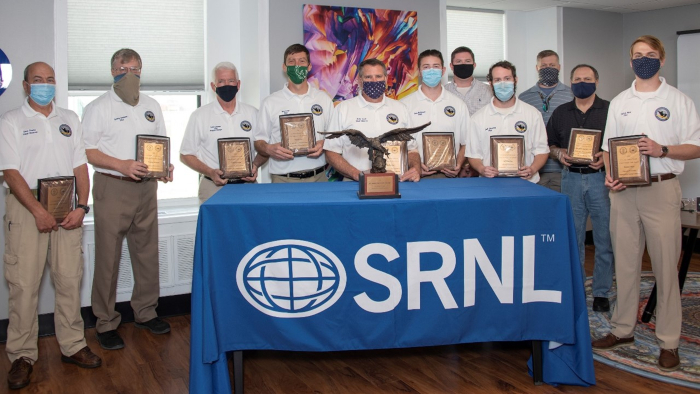 Savannah River National Laboratory’s Unmanned Aircraft System Team from left to right: Dave Premo, Tommy Sessions, Todd Coleman, Troy Lorier, Kirby Scott, Ben Robinson, Mark Spurlock, Jeff Steedley, Kyle Strom, Ron Bartholomew, and Dalton Hare.
AIKEN, S.C – Savannah River National Laboratory’s (SRNL) Unmanned Aircraft System (UAS) team has received the 2020 UAS Unit Award, a recognition for excellence given by the DOE’s Office of Aviation Management.
The award is based on criteria that include management, operations, maintenance, training, safety, and best practices. Nominations of UAS teams were reviewed and judged by a blue-ribbon panel, which included high-level military officers and aviation management professionals.
“The key to the success of this team was the hard work and partnership developed between the DOE and SRNL,” said Tony Polk, director of the DOE Savannah River Laboratory Office. “I look forward to seeing that partnership carried forward into future endeavors.”
SRNL’s UAS team comprises Federal Aviation Administration (FAA) certified pilots and visual observers. During the last fiscal year, SRNL logged more than 100 pilot hours and conducted missions that included infrastructure inspection, aerial photography and videography; emergency response exercise support; training and proficiency; research and development activities; and other U.S. government support.
“This was the first year that the DOE Office of Aviation Management included a UAS Unit Award in its annual DOE and Federal Safety Awards cycle. Being the recipient of the inaugural award truly validates all the planning and hard work by both the SRNL UAS Program and DOE oversight that goes into every UAS flight," DOE-SR Federal Aviation Manager Mark Spurlock said. "We look forward to continuing our focus on safety, professionalism, customer satisfaction, and broadening the UAS program’s mission scope in the next few years.”
The UAS unit currently has 10 aircraft in its inventory and the team works closely with the DOE-Savannah River aviation manager and safety officer to plan and conduct on-site missions under an approved flight readiness review board.
Additionally, the SRNL UAS unit recently received approval to conduct unmanned aircraft flights beyond the direct sight of the pilot and visual observer. This was the first such approval granted by the FAA in its eastern sector for a non-public safety organization. That sector includes 17 states from Mississippi to Maine.
 The Department of Energy recently sold 52 gondola cars that were used at the Savannah River Site for a cleanup project that began in 2009 and ended in 2011.
AIKEN, S.C. – EM’s Savannah River Site (SRS) sold 52 no-longer-needed special purpose railroad cars to an environmental cleanup company, a transaction that benefitted the U.S Treasury and enabled the site to avoid years of maintenance costs.
The 100-ton, top-loaded gondola railcars, initially purchased to support the now-closed Fernald site in southwest Ohio, were transferred to SRS in 2009 to support an environmental cleanup project that was completed two years later.
“This is a good example of proper stewardship and cost-effective use of government resources identified as surplus,” said Clarence Ruff, DOE-Savannah River traffic management specialist. “These gondola cars served an important purpose — at both Fernald and Savannah River — and have an estimated 20-plus years of service life remaining. Since a need for them no longer exists at SRS, reutilizing them with a company specializing in environmental restoration makes for a practical business solution.”
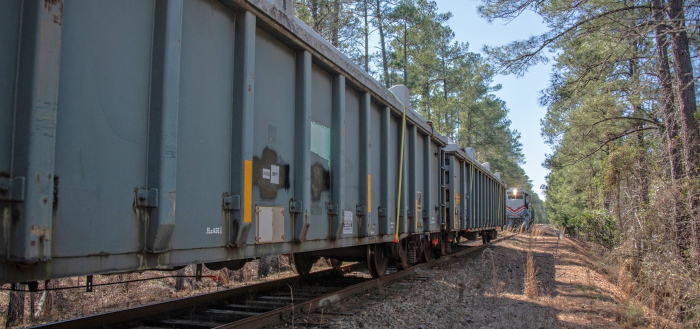 The specially constructed boxcars have transported low-level contaminated materials for decades, first at a former uranium processing plant near Cincinnati, Ohio, and then at the Savannah River Site.
SRS followed government procedure for the disposition of surplus property. In the end, the rail cars were sold to EnergySolutions for $350,000 in a competitive bid process. The proceeds were forwarded to the U.S. Treasury.
Ruff noted that EnergySolutions, an international nuclear services company based in Salt Lake City, has the expertise and resources to dispose of the cars safely and properly when they reach the end of their useful service, a significant cost avoidance for DOE.
A team of workers reporting to SRS contractor Savannah River Nuclear Solutions were assigned to ensure the gondola cars met all U.S. Department of Transportation standards and regulations before being transported to Utah.
The last of the cars will soon leave SRS for the EnergySolutions facility in Clive, Utah, to continue their useful role in cleaning up environmental contamination throughout the U.S.
-Contributor: DT Townsend
 UCOR and Roane State Community College representatives celebrate the company’s $50,000 donation that will be used for a new apprenticeship effort and to purchase equipment for the college’s chemical engineering technology laboratory. From left are UCOR Communications, Community, Diversity, and Workforce Development Programs Manager Sonya Johnson; UCOR Project Services and Support Deputy Manager Kala Dickerson; UCOR Administrative Services Manager Charles Malarkey; Roane State Community College President Chris Whaley; Roane State Foundation Executive Director Scott Niermann; Roane State Community College Chemical Engineering Technology Program Director Laura A. Hofman; and Dan Hyder, Roane State Community College Interim Dean for Social Science, Business and Education Director, Environmental Health Technology Program.
OAK RIDGE, Tenn. – Developing the cleanup workforce of tomorrow requires time and an emphasis and investment in science, technology, engineering, and math (STEM) education.
To reach that goal, Oak Ridge cleanup contractor UCOR is continuing its commitment to STEM education in the community, adding two new educational endeavors to its list of programs focused on reaching and educating students ranging from middle school to trade, community colleges and universities.
A recent $50,000 donation to Roane State Community College will support two STEM programs. Part of the donation will be used to purchase equipment for the college’s chemical engineering technology laboratory. UCOR also currently supports an apprenticeship program for second-year students pursuing a focus in chemical engineering technology at the school. In the past two years, UCOR has provided apprenticeships to eight students, and those who successfully complete the apprenticeships are offered jobs with the contractor. The remainder of the donation will support a new apprenticeship effort in the Environmental Health Technology Program.
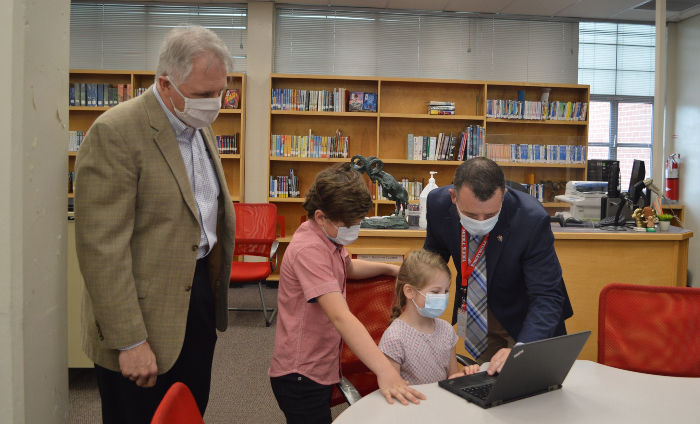 UCOR President and CEO Ken Rueter, left, and Kirk Renegar, an Oak Ridge School District principal, watch as local students use one of 100 new laptops the contractor donated to support virtual learning.
“STEM education is key to ensuring a pipeline of trained, skilled workers in the future,” said Charlie Malarkey, UCOR administrative services manager. “This apprenticeship program is another cog in our multi-faceted machinery to build the future cleanup workforce.”
UCOR also donated $80,000 to purchase 100 laptops for Oak Ridge schools. With virtual classrooms being the norm during the COVID-19 pandemic, this donation is helping keep kids on track in their studies and enables continued participation in STEM programs.
“We are proud to belong to a community that values academic excellence and is excited to support Oak Ridge schools during these unprecedented times,” said Sonya Johnson, UCOR manager of communications, community, diversity and workforce development programs. “Our donations to these and many other STEM efforts provide local students the skills and training necessary to position themselves for educational and career excellence.”
Other active STEM programs include awarding annual mini-grants to local teachers, employee volunteering in schools to discuss STEM-related careers, and sponsoring the first deactivation and demolition program in the country for nuclear engineering students at the University of Tennessee.
For more information about additional STEM and workforce efforts at DOE, visit STEM Rising.
-Contributor: Wayne McKinney
|